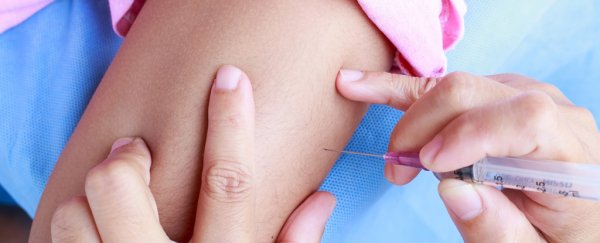The prevalence of human papillomavirus (HPV) in teenage girls in the US has dropped by almost two-thirds thanks to a vaccination program that began a decade ago, according to a new study.
The findings are especially important because HPV, which infects about 14 million Americans each year, is by far the most common cause of cervical cancer, in addition to a range of other cancers. Despite only limited numbers of young people at present being vaccinated – about 40 percent of girls and 20 percent of boys aged between 13 and 17 – the effort to head off the virus early could save thousands from developing cancerous growths later in life.
"We're seeing impact of the vaccination program and that's very encouraging, and it shows how effective the campaign is," epidemiologist Lauri E Markowitz of the National Centre for Immunisations and Respiratory Diseases told Amanda Holpuch at The Guardian. "[But it could] be even greater if we had higher coverage, and we know HPV coverage lags behind other adolescent vaccines."
According to the US Centres for Disease Control and Prevention (CDC), HPV is the most common sexually transmitted infection (STI) in the US, with about 79 million Americans currently infected. Most sexually active adults in the US will contract HPV at some point in their lives.
There's more than 40 types of the virus that infect humans, but most of these have only transient effects. However, some types persist and can cause cervical cancer, in addition to cancers of the anus, penis, vulva, and vagina, among others.
Fortunately, a vaccination to protect against HPV began being recommended in 2006 for women aged 11 to 26 years. There are now two vaccinations on the market, including one that covers males.
Using data from the National Health and Nutrition Examination Survey, researchers examined the prevalence of HPV in women aged 14 to 34 in the period 2009–2012, three years after the vaccination was introduced, and compared it with figures from the pre-vaccine era (2003–2006).
The findings, published in Pediatrics, show a 64 percent decrease in HPV prevalence among females aged 14 to 19 years, and a 34 percent decrease among those aged 20 to 24 years. The rates in older women had not fallen.
It's a promising start to locking down the virus, but according to the researchers, the decrease could be even greater if vaccine adoption were more widespread.
"HPV vaccination has the potential to prevent up to three out of four HPV-associated cancers," Markowitz told Reuters. "National HPV vaccination rates are low, leaving girls vulnerable not only to cervical cancer, but also to other cancers caused by HPV infections… HPV infections can also lead to cancers of the anus, penis, and oropharynx in boys, so these low rates also leave boys vulnerable to HPV cancers."
Unfortunately, one of the factors currently preventing greater uptake is the stigma surrounding the prescription of a STI-vaccination to children – but health experts say we need to overcome any social hesitation and focus on the outcomes, which in some cases could literally be life-saving.
In the US, 11,000 women are diagnosed with cervical cancer each year, and about 4,400 women die from the disease.
"The infection is sexually transmitted, but that doesn't need to be part of the conversation," paediatric specialist Joseph A. Bocchini Jr. of Louisiana State University, who was not involved with the study, told Jan Hoffman at The New York Times. "If a parent is concerned, physicians should be prepared to talk about it. But we don't really discuss how people become infected with every vaccine-preventable disease."
